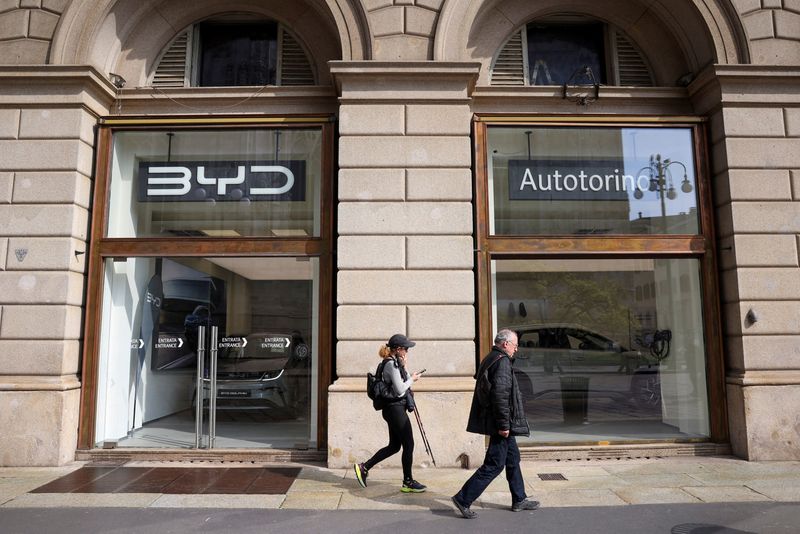By Giulio Piovaccari
MILAN (Reuters) – European governments may be wary of China’s electric vehicle budgets flooding the market, but they are also fiercely competing to win manufacturing investment and jobs brought by new competitors.
As the European Union investigates Chinese car subsidies and considers import tariffs, national governments in the bloc are suspending their own incentives to attract Chinese automakers who want to build European factories.
Manufacturing costs for Chinese EV makers including BYD, Chery Automobile and state-owned SAIC Motor are lower at home, but they are still looking to set up in Europe to build brands and save on shipping rates and potential, said Gianluca Di Loreto, a partner at consulting firm Bain & Company.
“Chinese car manufacturers know that their cars have to be considered European if they want to attract the interest of European customers,” he said. “This means producing in Europe.”
An EU tariff decision is expected this week. On the one hand, import taxes could help European automakers better compete with their Chinese counterparts, but it could also hurt Chinese automakers that have invested heavily, and for the long term, in Europe.
Chinese brand car sales accounted for 4% of the European market last year and are forecast to reach 7% by 2028, according to consulting firm AlixPartners.
Hungary, which is expected to produce around 500,000 vehicles by 2023, is getting its first European factory investment by a Chinese carmaker, which was announced last year by EV giant BYD which is also considering a second European factory in 2025.
Budapest is also negotiating with Great Wall Motor for its first European plant, local media have reported, with the country offering cash to create jobs, tax breaks and relaxed regulation in targeted zones to attract foreign investment.
Hungary has spent more than $1 billion in recent years to support new battery factories from South Korean groups SK On and Samsung SDI and a planned factory by Chinese battery giant CATL.
Representatives of BYD, Great Wall and Hungary did not respond to requests for comment.
China’s Leapmotor will use existing capacity from its Franco-Italian partner Stellantis, with Reuters reporting the pair have chosen the Tychy plant in Poland as their manufacturing base.
Poland has several programs that currently support investments of more than $10 billion, the country’s development and technology ministry told Reuters, including one that favors the transition to a net-zero economy and another that offers corporate income tax relief, up to 50% in areas of high unemployment.
SPAIN, ITALY CHASE EV FACTORY
Spain, Europe’s second largest car manufacturing country after Germany, has received investment from Chery, which will start production in the fourth quarter at a former Nissan facility in Barcelona with a local partner.
Chery is expected to benefit from Spain’s 3.7 billion euro program launched in 2020 to attract electric and battery plants.
China’s Envision Group has received 300 million euros in incentives under a scheme for a 2.5 billion battery factory creating 3,000 jobs. Spain may host Stellantis’ planned fourth gigafactory in Europe, with CATL.
Chery plans another, larger facility in Europe, a source with knowledge of the company’s plans to Reuters, and has held talks with the government including Rome, which is keen to attract other automakers to compete with Fiat-producer Stellantis.
Italy could launch a national automotive fund, worth 6 billion euros between 2025-2030, for incentives for car buyers and manufacturers. China’s Dongfeng is among several other automakers that have held investment talks with Rome.
Italy’s industry ministry declined to comment. Dongfeng and Chery did not respond to requests for comment.
SAIC, owner of the venerable MG brand, aims to build two European plants, two sources familiar with the matter told Reuters.
The first, based on existing facilities, could be announced from July and will use kit assembly techniques, with an annual production target of up to 50,000 vehicles, one of the sources said. SAIC’s second European plant will be built from scratch and produce up to 200,000 vehicles a year, the source added.
Germany, Italy, Spain and Hungary are on SAIC’s list of locations, the source said.
SAIC did not respond to a request for comment.
COST CONTROL IN EUROPE
In Europe, Chinese automakers face higher costs for everything from labor to energy to regulatory compliance.
But the cost of exporting made-in-China cars could increase rapidly and threaten already narrow margins.
Bain & Company’s Di Loreto said that a 15,000-euro car manufactured in China requires shipping and logistics costs of between 500 and 3,000 euros.
Chinese automakers may find labor costs in Northern Europe too high for competitive production, Di Loreto said, while in the south, Italy or Spain offer a balance of lower labor costs and relatively high manufacturing standards – especially important for vehicles premium.
For low-cost vehicles, Di Loreto said, interesting locations include Eastern Europe and Turkey, which currently produces around 1.5 million cars per year, mostly for the EU, and has been in talks with BYD, Chery, SAIC and Tembok Besar.
Turkey’s customs union with the European Union and free trade agreements with non-EU countries ensure tariff-free exports of vehicles and components.
(Reporting by Giulio Piovaccari; additional reporting by Giuseppe Fonte in Rome, Gilles Guillaume in Paris, Joan Faus in Barcelona, Anita Komuves in Budapest, Anna Koper and Marek Strzelecki in Warsaw and Can Sezer in Istanbul; writing by Giulio Piovaccari ; editing by Brian Thevenot, Kirsten Donovan)




